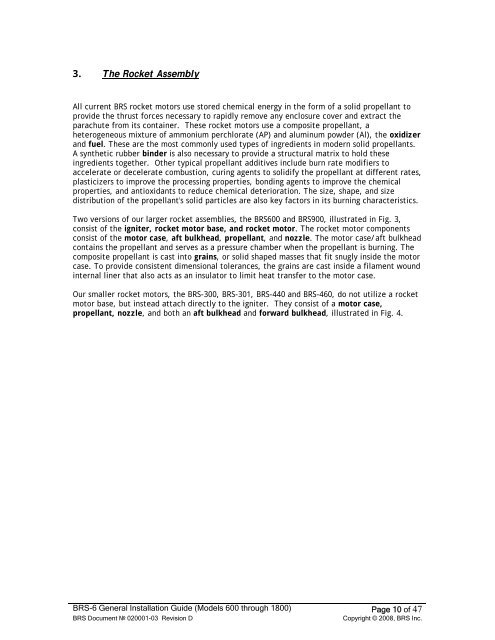BRS-6 General Installation Guide - CAFE Foundation
BRS-6 General Installation Guide - CAFE Foundation
BRS-6 General Installation Guide - CAFE Foundation
Create successful ePaper yourself
Turn your PDF publications into a flip-book with our unique Google optimized e-Paper software.
3. The Rocket Assembly<br />
All current <strong>BRS</strong> rocket motors use stored chemical energy in the form of a solid propellant to<br />
provide the thrust forces necessary to rapidly remove any enclosure cover and extract the<br />
parachute from its container. These rocket motors use a composite propellant, a<br />
heterogeneous mixture of ammonium perchlorate (AP) and aluminum powder (Al), the oxidizer<br />
and fuel. These are the most commonly used types of ingredients in modern solid propellants.<br />
A synthetic rubber binder is also necessary to provide a structural matrix to hold these<br />
ingredients together. Other typical propellant additives include burn rate modifiers to<br />
accelerate or decelerate combustion, curing agents to solidify the propellant at different rates,<br />
plasticizers to improve the processing properties, bonding agents to improve the chemical<br />
properties, and antioxidants to reduce chemical deterioration. The size, shape, and size<br />
distribution of the propellant's solid particles are also key factors in its burning characteristics.<br />
Two versions of our larger rocket assemblies, the <strong>BRS</strong>600 and <strong>BRS</strong>900, illustrated in Fig. 3,<br />
consist of the igniter, rocket motor base, and rocket motor. The rocket motor components<br />
consist of the motor case, aft bulkhead, propellant, and nozzle. The motor case/aft bulkhead<br />
contains the propellant and serves as a pressure chamber when the propellant is burning. The<br />
composite propellant is cast into grains, or solid shaped masses that fit snugly inside the motor<br />
case. To provide consistent dimensional tolerances, the grains are cast inside a filament wound<br />
internal liner that also acts as an insulator to limit heat transfer to the motor case.<br />
Our smaller rocket motors, the <strong>BRS</strong>-300, <strong>BRS</strong>-301, <strong>BRS</strong>-440 and <strong>BRS</strong>-460, do not utilize a rocket<br />
motor base, but instead attach directly to the igniter. They consist of a motor case,<br />
propellant, nozzle, and both an aft bulkhead and forward bulkhead, illustrated in Fig. 4.<br />
<strong>BRS</strong>-6 <strong>General</strong> <strong>Installation</strong> <strong>Guide</strong> (Models 600 through 1800) Page 10 of 47<br />
<strong>BRS</strong> Document № 020001-03 Revision D Copyright © 2008, <strong>BRS</strong> Inc.

















